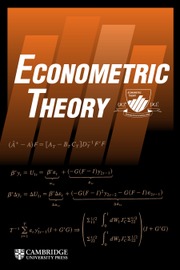No CrossRef data available.
Article contents
LEARNING MARKOV PROCESSES WITH LATENT VARIABLES
Published online by Cambridge University Press: 13 February 2025
Abstract
We consider the problem of identifying the parameters of a time-homogeneous bivariate Markov chain when only one of the two variables is observable. We show that, subject to conditions that we spell out, the transition kernel and the distribution of the initial condition are uniquely recoverable (up to an arbitrary relabelling of the state space of the latent variable) from the joint distribution of four (or more) consecutive time-series observations. The result is, therefore, applicable to (short) panel data as well as to (stationary) time series data.
- Type
- ARTICLES
- Information
- Copyright
- © The Author(s), 2025. Published by Cambridge University Press
Footnotes
We are grateful to Anna Mikusheva, Peter Phillips, and two anonymous referees for constructive feedback. Financial support from the European Research Council, grant ERC-2016-STG-715787, and from the French Government and the ANR under the Investissements d’ Avenir program, grant ANR-17-EURE-0010 is gratefully acknowledged.


